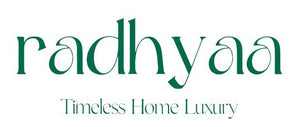The History and Charm of Antique Brass Bowls: The Collector's Guide | Radhyaa
Antique brass bowls look rather timeless, and this is the reason they have always been considered as collectibles throughout the centuries. The technique of producing these objects, their design that provides warmth at night and the feeling of warmth at home make these beautiful and functional objects very popular. As an enthusiast or collector - it is worth turning to this blog to delve into some of the major parameters of any antique brass bowl.

The Origins and History
Artifacts or antique brass bowl date back to earliest times and were used by a number of great cultures of the past. The earliest brassy utensils and other objects can be traced back to more than five thousand years back present day India and Pakistan region that was home to the Indus valley civilization. Another important application of brass was in the making of bowls and cups which have been found in ancient Greece, Rome and Egypt.
The Medieval period in the Middle East and Central Asia heralded the glory days of brass work in terms of artistry and fluent workmanship. The artistic embellishment that artisans employed when working on brass included engraving, filigree, and inlaying. Toilet articles and other metalwares are one of the most exquisite Ottoman art forms, which employed techniques similar to those of today’s Morocco, Egypt and India. During the 17th and 18th centuries, as trade spread throughout Europe, brassware from Asia and the Middle East reached European shores.
Antique or Vintage: Key Identification Tips
When shopping for antique brass bowl, it helps to understand some identification pointers that distinguish true antiques from more recent vintage pieces:
- Details: Use the appearance of engraved or embossed motives to determine their quality and the level of detail. Hand engraving is a very delicate and intricate process and even the most skilled engravers are prone to slight mistakes that can be traced to their antiques.
- Thickness: Take time to assess the thickness and texture of the metal that will be used for your kitchen utensils. Newer brasses on the other hand are sometimes called modern brasses as they are relatively of lower copper content and therefore less dense and less hard when compared to antique brass.
- Damage: Old scratches, small dents and rough oxidation marks are also some of the features that can signal damage. Real brass is not polished and shiny like the newly produced one but it may have some tarnish that shows it has been used for decades or centuries.
- Design: Think about patterns and ornaments on furniture as well as any additional elements in the furniture. Designs of plant-like shapes and geometrical shapes present cultural features of brass that may be associated with the culture of using the piece.
If you follow these tips, it will be much easier to know the difference between an antique and a piece of brassware made in the mid century.
Antique Brass Bowls Named Across Cultures
Delicate garnished Indian ganjifa to Egyptian reviving bowls, influences from various cultures have contributed to the development of antique brass bowl throughout the ages. Here is just a small sampling of some of the more distinctive ethnic brass bowl varieties collectors may encounter:
- Moroccan and Egyptian Mosque Lamps: With cutouts designed with geometrical patterns of various shapes, so that it is possible to see through the organa. Sometimes, they are engraved or even studded with tiny stones.
- Ottoman Turkish Basins and Ewers: Extra-large dishes or bowls with a large central protuberance and elongated handles on jugs with floral and script engravings.
- Indian Betel Nut Boxes: Small containers with lids in which paan mixture could be kept with divided sections, beautifully carved with floral engravings and images of gods and goddesses, Krishan being important among them.
- Yemen and Oman Spice/Coffee Pots: Tall, slender pots with narrow necks which are curved like a swan’s neck and sometimes engraved and studded with brass or silver.
Caring for Your Collection
While using brass bowls there are some basic precautions needed to be taken in order to maintain its antique looks.
- Do not over-polish the engraved areas mainly because polishing compounds cause the detailed etching to wear away gradually.
- Apply a thin coat of wax or lacquer to the engraved surfaces in order to ensure that the area remains protected in future without losing the antique look of the metal.
- It is advisable to store items away from humidity and avoid dropping or sliding the items during movement as this causes dents.
If you look after your brass bowl properly, your future generations may also be able to use that bowl.

Conclusion
For many collectors, whether you are beginning a new collection or building upon an old one, the process of finding just the right piece anchors you in a culture and in history in a most immediate and visceral way. To decorate your home with an antique brass bowl, pay a visit to Radhyaa and witness modern day brass luxury!

